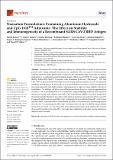Nanoalum Formulations Containing Aluminum Hydroxide and CpG 1018TM Adjuvants: The Effect on Stability and Immunogenicity of a Recombinant SARS-CoV-2 RBD Antigen
Author(s)
Bajoria, Sakshi; Kumru, Ozan S.; Doering, Jennifer; Berman, Katherine; Slyke, Greta Van; Prigodich, Anneka; Rodriguez-Aponte, Sergio A.; Kleanthous, Harry; Love, J. Christopher; Mantis, Nicholas J.; Joshi, Sangeeta B.; Volkin, David B.; ... Show more Show less
Downloadvaccines-11-01030-v2.pdf (2.389Mb)
Publisher with Creative Commons License
Publisher with Creative Commons License
Creative Commons Attribution
Terms of use
Metadata
Show full item recordAbstract
Aluminum-salt vaccine adjuvants (alum) are commercially available as micron-sized particles with varying chemical composition and crystallinity. There are reports of enhanced adjuvanticity when the alum’s particle size is reduced to the nanometer range. Previously, we demonstrated that a recombinant receptor-binding domain (RBD)-based COVID-19 vaccine candidate (RBD-J; RBD-L452K-F490W) formulated with aluminum hydroxide (Alhydrogel<sup>®</sup>; AH) and CpG 1018™ (CpG) adjuvants induced potent neutralizing antibody responses in mice yet displayed instability during storage. In this work, we evaluated whether sonication of AH to the nanometer size range (nanoAH) could further enhance immunogenicity or improve storage stability of the above formulation. The addition of CpG to nanoAH (at mouse doses), however, caused re-agglomeration of nanoAH. AH-CpG interactions were evaluated by Langmuir binding isotherms and zeta potential measurements, and stabilized nanoAH + CpG formulations of RBD-J were then designed by (1) optimizing CpG:Aluminum dose ratios or (2) adding a small-molecule polyanion (phytic acid, PA). Compared with the micron-sized AH + CpG formulation, the two stabilized nanoAH + CpG formulations of RBD-J demonstrated no enhancement in SARS-CoV-2 pseudovirus neutralizing titers in mice, but the PA-containing nanoAH + CpG formulation showed improved RBD-J storage stability trends (at 4, 25, and 37 °C). The formulation protocols presented herein can be employed to evaluate the potential benefits of the nanoAH + CpG adjuvant combination with other vaccine antigens in different animal models.
Date issued
2023-05-26Department
Massachusetts Institute of Technology. Department of Biological Engineering; Koch Institute for Integrative Cancer Research at MIT; Massachusetts Institute of Technology. Department of Chemical EngineeringPublisher
Multidisciplinary Digital Publishing Institute
Citation
Vaccines 11 (6): 1030 (2023)
Version: Final published version